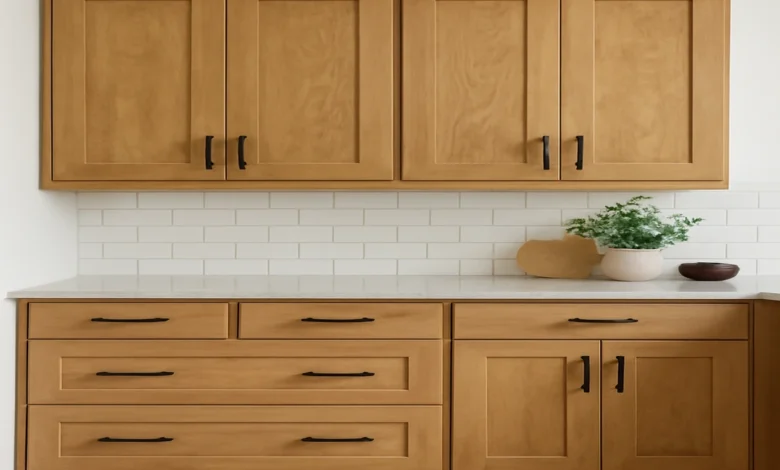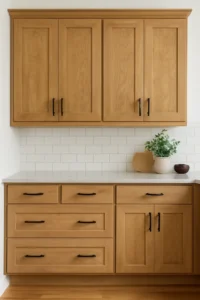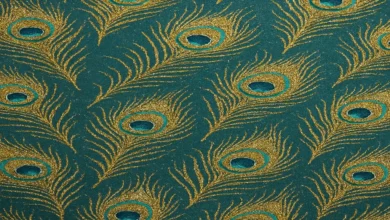White Oak wood Cabinets: Everything You Need to Know

White oak wood cabinets play a very attractive and sturdy role in the kitchen. Be it the homeowner or the interior designer, white oak has gained popularity in the hearts of people. Known for their durability, versatility, and natural beauty, white oak cabinets can enhance the look and feel of any kitchen, whether traditional, transitional, or modern. In this article, we’ll explore everything you need to know about white oak kitchen cabinets, including their features, benefits, design trends, maintenance, and more.
What is White Oak?
White oak is a species of wood known for its strength, tight grain pattern, and resistance to moisture. Unlike red oak, which has a pinkish hue, oak has an earthier to golden hue. This wood tree grows mainly in North America and is used for furniture, flooring, and cabinet making due to its aesthetic and structural strength. Furniture made from this wood is very beautiful and lasts a very long time.
Types of White Oak
As part of the Quercus genus, white oak is commonly utilized in making furniture, flooring, cabinetry, boats, and barrels. However, like several species, not all white oaks are the same; there are different species with specific traits, grain patterns, and uses.
Let’s examine each of these major types of white oak one by one:
1. Quercus alba (American White Oak)
Origin: Eastern and Central North America
Wood Characteristics:
- Color: Light to medium brown, often with an olive cast
- Grain: Straight-grained, with a coarse, uneven texture
- Durability: Highly durable and rot-resistant
- Workability: Easy to machine, stain, and finish
Uses:
American white oak is the most commonly used species. Its tight grain structure makes it water-resistant, which is why it’s used for wine and whiskey barrels, flooring, furniture, and veneers.
2. Quercus robur (European White Oak)
Origin: Europe and Western Asia
Wood Characteristics:
- Color: Light brown with a yellowish or golden hue
- Grain: More prominent and wavy compared to American white oak
- Durability: Very durable and slightly denser than its American cousin
- Workability: Excellent, though the higher tannin content can affect finishes.
Uses:
European white oak is widely used in traditional and high-end furniture, architectural joinery, and boatbuilding. It’s also favored for wine barrels due to its strong tannin content.
3. Quercus montana (Chestnut Oak)
Origin: Eastern United States (Appalachian Mountains)
Wood Characteristics:
- Color: Medium to dark brown
- Grain: Coarse texture, similar to chestnut (hence the name)
- Durability: Hard and heavy, with good resistance to wear
- Workability: A bit harder to work with due to density
Uses:
Often used in railroad ties, fencing, and heavy timber construction. While not as widely used in furniture, it’s sometimes chosen for rustic designs.
4. Quercus lyrata (Overcup Oak)
Origin: Southeastern United States, especially in floodplains
Wood Characteristics:
- Color: Pale brown with occasional grayish tones
- Grain: Similar to other white oaks, though slightly less refined
- Durability: Moderately durable
- Workability: Not commonly used commercially
Uses:
Overcup oak is not as popular in commercial markets but is valued in ecological restoration and landscaping. When used, it functions similarly to white oak.
5. Quercus macrocarpa (Bur Oak)
Origin: Central and Eastern North America
Wood Characteristics:
- Color: Light to dark brown
- Grain: Coarse and open, with dramatic ray flecks in quarter-sawn cuts
- Durability: Extremely durable and weather-resistant
- Workability: Tough to mill but finishes beautifully.
Uses:
Bur oak is ideal for outdoor furniture, fence posts, and heavy construction. Its rot resistance makes it excellent for exposed structures.

Key Features of White Oak Cabinets
Durability
White oak falls under the wood category, which makes it highly resistant to dents, scratches, and daily wear and tear, and that is why we use it the most in our kitchens.
Grain Pattern
White oak typically has a straight, tight grain that gives a clean and elegant appearance. Rift-sawn and quarter-sawn cuts further enhance this effect, providing a more linear and uniform grain.
Color Variations
The natural tone of white oak ranges from light beige to soft brown with an occasional golden hue. It takes stains and finishes very well, allowing for a variety of looks.
Water Resistance
Because of its closed grain structure, white oak is naturally more resistant to moisture than many other woods, making it a practical choice for kitchen environments.
Cost of White Oak Cabinets
White oak cabinets are generally more expensive than common woods like pine or birch but more affordable than exotic hardwoods. On average, they range from $150 to $500 per linear foot, depending on the construction method (stock, semi custom, or custom), finish, and hardware.
White Oak vs. Red Oak Cabinets
| Feature | White Oak | Red Oak |
| Grain Pattern | Straighter, tighter | More prominent, wavy |
| Color Tone | Light beige to golden | Reddish to pinkish tones |
| Cost | Slightly more expensive | More affordable |
| Aesthetic | Modern and versatile | Traditional and rustic |
| Water Resistance | Higher | Moderate |
Benefits of White Oak Cabinets
White oak cabinets combine elegance with practicality, making them perfect for bathrooms and kitchens. Here are some key benefits:
Strength and Durability— Losing shape over time will not be a concern when it comes to white oak cabinets, as the wood is a hardy, dense material that stands up to the abuse of wear and tear.
Water Resistance— Unlike other types of wood, rainfall does not affect white oak as much because of its tight grain structure, thus reducing any chance of warping or damage.
Versatility— A large range of colors can be achieved through the use of different stains and finishes due to its easy acceptance on both surfaces.
Value Boost— White oak is considered a high-quality material, which improves appeal rate, thus increasing the overall value of your house.
Conclusion
White oak kitchen cabinets are an outstanding combination of beauty, strength, and eco-friendliness. From modern minimalist to rustic farmhouse, white oak can match almost any aesthetic. Their upfront cost is higher compared to alternatives, but the long-term value, charm, and durability they bring make them a wise investment in any home.
Due to its understated grace and enduring function lifespan, white oak cabinets should be given careful thought by anyone looking to remodel an existing kitchen or construct a new one.
Also Read: Is Teak Wood Good for Beds? A Comprehensive Guide
If you want to read more interesting content, follow the ACTION TIME USA!


